The Hydrolysis Rate of Paraoxonase-1 Q and R Isoenzymes: An In Silico Study Based on In Vitro Data
Abstract
1. Introduction
2. Materials and Methods
3. Results and Discussion
4. Conclusions
Supplementary Materials
Author Contributions
Funding
Institutional Review Board Statement
Informed Consent Statement
Data Availability Statement
Acknowledgments
Conflicts of Interest
References
- Tripathy, R.K.; Aggarwal, G.; Bajaj, P.; Kathuria, D.; Bharatam, P.V.; Pande, A.H. Towards Understanding the Catalytic Mechanism of Human Paraoxonase 1: Experimental and In Silico Mutagenesis Studies. Appl. Biochem. Biotechnol. 2017, 182, 1642–1662. [Google Scholar] [CrossRef] [PubMed]
- Aviram, M.; Rosenblat, M.; Bisgaier, C.L.; Newton, R.S.; Primo-Parmo, S.L.; Du, B.N. La A Possible Role for Paraoxonase Paraoxonase Inhibits High-Density Lipoprotein Oxidation and Preserves Its Functions. A Possible Peroxidative Role for Paraoxonase Paraoxonase. HDL LDL Lipid Peroxidation Apolipoprotein E Deficient Mice. J. Clin. Investig. 1998, 101, 1581–1590. [Google Scholar] [CrossRef] [PubMed]
- Deakin, S.; Leviev, I.; Gomaraschi, M.; Calabresi, L.; Franceschini, G.; James, R.W. Enzymatically Active Paraoxonase-1 Is Located at the External Membrane of Producing Cells and Released by a High Affinity, Saturable, Desorption Mechanism. J. Biol. Chem. 2002, 277, 4301–4308. [Google Scholar] [CrossRef] [PubMed]
- Blanco-Muñoz, J.; Lacasaña, M.; Gamboa, R.; Huesca-Gómez, C.; Hernández-Mariano, J.Á.; Aguilar-Garduño, C. Interaction between MTHFR 677C > T, PON1 192Q > R and PON1 55L > M Polymorphisms and Its Effect on Non-Recurrent Spontaneous Abortion in Mexican Women. Gene 2019, 689, 69–75. [Google Scholar] [CrossRef]
- Davidson, W.S.; Silva, R.A.G.D.; Chantepie, S.; Lagor, W.R.; Chapman, M.J.; Kontush, A. Proteomic Analysis of Defined HDL Subpopulations Reveals Particle-Specific Protein Clusters: Relevance to Antioxidative Function. Arterioscler. Thromb. Vasc. Biol. 2009, 29, 870–876. [Google Scholar] [CrossRef]
- Kulka, M. A Review of Paraoxonase 1 Properties and Diagnostic Applications. Pol. J. Vet. Sci. 2016, 19, 225–232. [Google Scholar] [CrossRef]
- Mackness, M.; Mackness, B. Human Paraoxonase-1 (PON1): Gene Structure and Expression, Promiscuous Activities and Multiple Physiological Roles. Gene 2015, 567, 12–21. [Google Scholar] [CrossRef]
- Costa, L.G.; Cole, T.B.; Jarvik, G.P.; Furlong, C.E. Functional Genomics of the Paraoxonase (PON1) Polymorphisms: Effects on Pesticide Sensitivity, Cardiovascular Disease, and Drug Metabolism. Annu. Rev. Med. 2003, 54, 371–392. [Google Scholar] [CrossRef]
- Taler-Verčič, A.; Goličnik, M.; Bavec, A. The Structure and Function of Paraoxonase-1 and Its Comparison to Paraoxonase-2 and -3. Molecules 2020, 25, 5980. [Google Scholar] [CrossRef]
- Rajkovic, M.G.; Rumora, L.; Barisic, K. Humana Paraoksonaza 1, 2 i 3. Biochem. Med. 2011, 21, 122–130. [Google Scholar] [CrossRef]
- Khersonsky, O.; Tawfik, D.S. Structure-Reactivity Studies of Serum Paraoxonase PON1 Suggest That Its Native Activity Is Lactonase. Biochemistry 2005, 44, 6371–6382. [Google Scholar] [CrossRef]
- Draganov, D.I.; Teiber, J.F.; Speelman, A.; Osawa, Y.; Sunahara, R.; La Du, B.N. Human Paraoxonases (PON1, PON2, and PON3) Are Lactonases with Overlapping and Distinct Substrate Specificities. J. Lipid Res. 2005, 46, 1239–1247. [Google Scholar] [CrossRef] [PubMed]
- Aldridge, W.N.; Hoskin, F.C.G.; Reiner, E.; Walker, C.H. Suggestions for a Nomenclature and Classification of Enzymes Hydrolysing Organophosphorus Compounds. In Enzymes Hydrolysing Organophosphorus Compounds; Ellis Horwood: Chichester, UK, 1989; pp. 246–253. [Google Scholar]
- Purg, M.; Elias, M.; Kamerlin, S.C.L. Similar Active Sites and Mechanisms Do Not Lead to Cross-Promiscuity in Organophosphate Hydrolysis: Implications for Biotherapeutic Engineering. J. Am. Chem. Soc. 2017, 139, 17533–17546. [Google Scholar] [CrossRef] [PubMed]
- Mazur, A. An Enzyme in Animal Tissues Capable of Hydrolysing the Phosphorus-Fluorine Bond of Alkyl Fluorophosphates. J. Biol. Chem. 1946, 164, 271–289. [Google Scholar] [CrossRef]
- Aldridge, W.N. Serum Esterases. II. An Enzyme Hydrolysing Diethyl p-Nitrophenyl Phosphate (E600) and Its Identity with the A-Esterase of Mammalian Sera. Biochem. J. 1953, 53, 117–124. [Google Scholar] [CrossRef] [PubMed]
- Harel, M.; Aharoni, A.; Gaidukov, L.; Brumshtein, B.; Khersonsky, O.; Meged, R.; Dvir, H.; Ravelli, R.B.G.; McCarthy, A.; Toker, L.; et al. Structure and Evolution of the Serum Paraoxonase Family of Detoxifying and Anti-Atherosclerotic Enzymes. Nat. Struct. Mol. Biol. 2004, 11, 412–419. [Google Scholar] [CrossRef]
- Khersonsky, O.; Tawfik, D.S. The Histidine 115-Histidine 134 Dyad Mediates the Lactonase Activity of Mammalian Serum Paraoxonases. J. Biol. Chem. 2006, 281, 7649–7656. [Google Scholar] [CrossRef]
- Le, Q.A.T.; Kim, S.; Chang, R.; Kim, Y.H. Insights into the Lactonase Mechanism of Serum Paraoxonase 1 (PON1): Experimental and Quantum Mechanics/Molecular Mechanics (QM/MM) Studies. J. Phys. Chem. B 2015, 119, 9571–9585. [Google Scholar] [CrossRef]
- Rosenblat, M.; Gaidukov, L.; Khersonsky, O.; Vaya, J.; Oren, R.; Tawfik, D.S.; Aviram, M. The Catalytic Histidine Dyad of High Density Lipoprotein-Associated Serum Paraoxonase-1 (PON1) Is Essential for PON1-Mediated Inhibition of Low Density Lipoprotein Oxidation and Stimulation of Macrophage Cholesterol Efflux. J. Biol. Chem. 2006, 281, 7657–7665. [Google Scholar] [CrossRef]
- Billecke, S.; Draganov, D.; Counsell, R.; Stetson, P.; Watson, C.; Hsu, C.; La Du, B.N. Human Serum Paraoxonase (PON1) Isozymes Q and R Hydrolyze Lactones and Cyclic Carbonate Esters. Drug Metab. Dispos. 2000, 28, 1335–1342. [Google Scholar]
- Mackness, B.; Mackness, M.I.; Arrol, S.; Turkie, W.; Durrington, P.N. Effect of the Molecular Polymorphisms of Human Paraoxonase (PON1) on the Rate of Hydrolysis of Paraoxon. Br. J. Pharmacol. 1997, 122, 265–268. [Google Scholar] [CrossRef] [PubMed]
- Blatter Garin, M.C.; James, R.W.; Dussoix, P.; Blanché, H.; Passa, P.; Froguel, P.; Ruiz, J. Paraoxonase Polymorphism Met-Leu54 Is Associated with Modified Serum Concentrations of the Enzyme. A Possible Link between the Paraoxonase Gene and Increased Risk of Cardiovascular Disease in Diabetes. J. Clin. Investig. 1997, 99, 62–66. [Google Scholar] [CrossRef] [PubMed]
- Playfer, J.R.; Eze, L.C.; Bullen, M.F.; Evans, D.A. Genetic Polymorphism and Interethnic Variability of Plasma Paroxonase Activity. J. Med. Genet. 1976, 13, 337–342. [Google Scholar] [CrossRef] [PubMed]
- Smolen, A.; Eckerson, H.W.; Gan, K.N.; Hailat, N.; La Du, B.N. Characteristics of the Genetically Determined Allozymic Forms of Human Serum Paraoxonase/Arylesterase. Drug Metab. Dispos. 1991, 19, 107–112. [Google Scholar] [PubMed]
- Humbert, R.; Adler, D.A.; Disteche, C.M.; Hassett, C.; Omiecinski, C.J.; Furlong, C.E. The Molecular Basis of the Human Serum Paraoxonase Activity Polymorphism. Nat. Genet. 1993, 3, 73–76. [Google Scholar] [CrossRef]
- Baillie, T.A.; Moldeus, P.; Mason, R.P.; Younes, M. Enzymes Interacting with Organophosphorus Compounds; Elsevier Scientific Publishers Ireland Ltd: Shannon, Ireland, 1993; Volume 6. [Google Scholar]
- Davies, H.G.; Richter, R.J.; Keifer, M.; Broomfield, C.A.; Sowalla, J.; Furlong, C.E. The Effect of the Human Serum Paraoxonase Polymorphism Is Reversed with Diazoxon, Soman and Sarin. Nat. Genet. 1996, 14, 334–336. [Google Scholar] [CrossRef]
- Reiner, E. Third International Meeting on Esterases Reacting with Organophosphorus Compounds; DTIC Document; Institute For Medical Research And Occupational Health: Zagreb, Croatia, 1998. [Google Scholar]
- Phuntuwate, W.; Suthisisang, C.; Koanantakul, B.; Chaloeiphap, P.; Mackness, B.; Mackness, M. Effect of Fenofibrate Therapy on Paraoxonase1 Status in Patients with Low HDL-C Levels. Atherosclerosis 2008, 196, 122–128. [Google Scholar] [CrossRef]
- Mitra, S.; Kshatriya, G.K. Genetic Variation at Q192R and L55M Polymorphisms in PON1. Environ. Toxicol. Pharmacol. 2016, 45, 251–256. [Google Scholar] [CrossRef]
- Ruiz, J.; Blanche, H.; James, R.W.; Garin, M.C.; Vaisse, C.; Charpentier, G.; Cohen, N.; Morabia, A.; Passa, P.; Froguel, P. Gln-Arg192 Polymorphism of Paraoxonase and Coronary Heart Disease in Type 2 Diabetes. Lancet 1995, 346, 869–872. [Google Scholar] [CrossRef]
- Serrato, M.; Marian, A.J. A Variant of Human Paraoxonase/Arylesterase (HUMPONA) Gene Is a Risk Factor for Coronary Artery Disease. J. Clin. Investig. 1995, 96, 3005–3008. [Google Scholar] [CrossRef][Green Version]
- Antikainen, M.; Murtomaki, S.; Syvanne, M.; Pahlman, R.; Tahvanainen, E.; Jauhiainen, M.; Frick, M.H.; Ehnholm, C. The Gln-Arg191 Polymorphism of the Human Paraoxonase Gene (HUMPONA) Is Not Associated with the Risk of Coronary Artery Disease in Finns. J. Clin. Investig. 1996, 98, 883–885. [Google Scholar] [CrossRef] [PubMed]
- Herrmann, S.M.; Blanc, H.; Poirier, O.; Arveiler, D.; Luc, G.; Evans, A.; Marques-Vidal, P.; Bard, J.M.; Cambien, F. The Gln/Arg Polymorphism of Human Paraoxonase (PON 192) Is Not Related to Myocardial Infarction in the ECTIM Study. Atherosclerosis 1996, 126, 299–303. [Google Scholar] [CrossRef]
- Suehiro, T.; Nakauchi, Y.; Yamamoto, M.; Arii, K.; Itoh, H.; Hamashige, N.; Hashimoto, K. Paraoxonase Gene Polymorphism in Japanese Subjects with Coronary Heart Disease. Int. J. Cardiol. 1996, 57, 69–73. [Google Scholar] [CrossRef]
- Murillo-González, F.E.; Ponce-Ruiz, N.; Rojas-García, A.E.; Rothenberg, S.J.; Bernal-Hernández, Y.Y.; Cerda-Flores, R.M.; Mackness, M.; Barrón-Vivanco, B.S.; González-Arias, C.A.; Ponce-Gallegos, J.; et al. PON1 Lactonase Activity and Its Association with Cardiovascular Disease. Clin. Chim. Acta 2020, 500, 47–53. [Google Scholar] [CrossRef] [PubMed]
- Schmidt, H.; Schmidt, R.; Niederkorn, K.; Gradert, A.; Schumacher, M.; Watzinger, N.; Hartung, H.P.; Kostner, G.M. Paraoxonase PON1 Polymorphism Leu-Met54 Is Associated with Carotid Atherosclerosis: Results of the Austrian Stroke Prevention Study. Stroke 1998, 29, 2043–2048. [Google Scholar] [CrossRef]
- Kondo, I.; Yamamoto, M. Genetic Polymorphism of Paraoxonase 1 (PON1) and Susceptibility to Parkinson’s Disease. Brain Res. 1998, 806, 271–273. [Google Scholar] [CrossRef]
- Furlong, C.E.; Suzuki, S.M.; Stevens, R.C.; Marsillach, J.; Richter, R.J.; Jarvik, G.P.; Checkoway, H.; Samii, A.; Costa, L.G.; Griffith, A.; et al. Human PON1, a biomarker of risk of disease and exposure. Chem.-Biol. Interac. 2010, 187, 355–361. [Google Scholar] [CrossRef]
- Atasoy, H.; Gulec-Yilmaz, S.; Ergen, A.; Gormus, U.; Kucukhuseyin, O.; Dalan, B.; Kusat Ol, K.; Ogut, D.B.; Gulec, H.; Cetin, B.; et al. Paraoxonase1 192 (PON1 192) Gene Polymorphism and Serum Paraoxonase Activity in Panic Disorder Patients. In Vivo 2015, 29, 51–54. [Google Scholar]
- Salari, N.; Rasoulpoor, S.; Hosseinian-Far, A.; Razazian, N.; Mansouri, K.; Mohammadi, M.; Vaisi-Raygani, A.; Jalali, R.; Shabani, S. Association between Serum Paraoxonase 1 Activity and Its Polymorphisms with Multiple Sclerosis: A Systematic Review. Neurol. Sci. 2021, 42, 491–500. [Google Scholar] [CrossRef]
- Kalman, J.; Kudchodkar, B.J.; Murray, K.; McConathy, W.J.; Juhasz, A.; Janka, Z.; Lacko, A.G. Evaluation of Serum-Lipid-Related Cardiovascular Risk Factors in Alzheimer’s Disease. Dement. Geriatr. Cogn. Disord. 1999, 10, 488–493. [Google Scholar] [CrossRef]
- Mogarekar, M.R.; Dhabe, M.G.; Gujrathi, C.C. A Study of Paraoxonase1 (PON1) Activities, HDL Cholesterol and Its Association with Vascular Complication in Type 2 Diabetes Mellitus. Int. J. Diabetes Dev. Ctries. 2016, 36, 457–462. [Google Scholar] [CrossRef]
- Ayan, D.; Şeneş, M.; Çaycl, A.B.; Söylemez, S.; Eren, N.; Altuntaş, Y.; Öztürk, F.Y. Evaluation of Paraoxonase, Arylesterase, and Homocysteine Thiolactonase Activities in Patients with Diabetes and Incipient Diabetes Nephropathy. J. Med. Biochem. 2019, 38, 481–488. [Google Scholar] [CrossRef] [PubMed]
- Moreira, E.G.; Boll, K.M.; Correia, D.G.; Soares, J.F.; Rigobello, C.; Maes, M. Why Should Psychiatrists and Neuroscientists Worry about Paraoxonase 1? Curr. Neuropharmacol. 2018, 17, 1004–1020. [Google Scholar] [CrossRef] [PubMed]
- Bosak, A.; Bavec, A.; Konte, T.; Šinko, G.; Kovarik, Z.; Goličnik, M. Interactions of Paraoxonase-1 with Pharmacologically Relevant Carbamates. Molecules 2020, 25, 211. [Google Scholar] [CrossRef]
- Karabulut, S.; Sizochenko, N.; Orhan, A.; Leszczynski, J. A DFT-Based QSAR Study on Inhibition of Human Dihydrofolate Reductase. J. Mol. Graph. Model. 2016, 70, 23–29. [Google Scholar] [CrossRef]
- Rasulev, B.; Kušić, H.; Leszczynska, D.; Leszczynski, J.; Koprivanac, N. QSAR Modeling of Acute Toxicity on Mammals Caused by Aromatic Compounds: The Case Study Using Oral LD50 for Rats. J. Environ. Monit. 2010, 12, 1037–1044. [Google Scholar] [CrossRef]
- Topliss, J.G.; Edwards, R.P. Chance Factors in Qsar Studies. ACS Symp. Ser. 1979, 22, 131–145. [Google Scholar] [CrossRef]
- European Commission Environment Directorate General Guidance. Document on the Validation of (Quantitative) Structure-Activity Relationships [(Q)Sar] Models; OECD: Paris, France, 2014; pp. 1–154. [CrossRef]
- Sun, G.; Zhang, Y.; Pei, L.; Lou, Y.; Mu, Y.; Yun, J.; Li, F.; Wang, Y.; Hao, Z.; Xi, S.; et al. Chemometric QSAR Modeling of Acute Oral Toxicity of Polycyclic Aromatic Hydrocarbons (PAHs) to Rat Using Simple 2D Descriptors and Interspecies Toxicity Modeling with Mouse. Ecotoxicol. Environ. Saf. 2021, 222, 112525. [Google Scholar] [CrossRef]
- Molecular Operating Environment (MOE); Chemical Computing Group ULC: Montreal, QC, Canada, 2022.
- Mauri, A.; Consonni, V.; Pavan, M.; Todeschini, R. DRAGON Software: An Easy Approach to Molecular Descriptor Calculations. Match 2006, 56, 237–248. [Google Scholar]
- Frisch, M.J.; Trucks, G.W.; Schlegel, H.B.; Scuseria, G.E.; Robb, M.A.; Cheeseman, J.R.; Scalmani, G.; Barone, V.; Petersson, G.A.; Nakatsuji, H. Gaussian 16 Rev. C.01.; Gaussian, Inc.: Wallingford, UK, 2016. [Google Scholar]
- Gramatica, P.; Chirico, N.; Papa, E.; Cassani, S.; Kovarich, S. QSARINS: A New Software for the Development, Analysis, and Validation of QSAR MLR Models. J. Comput. Chem. 2013, 34, 2121–2132. [Google Scholar] [CrossRef]
- Schrödinger, L.; DeLano, W. PyMOL. 2020. Available online: http://www.pymol.org/pymol (accessed on 10 January 2022).
- Case, W.T.; Babin, V.; Berryman, J.; Betz, R.M.; Cai, Q.; Cerutti, D.S.; Cheatham, T.; Darden, T.; Duke, R.; Gohlke, H.; et al. AMBER 14; Technical Report; University of California: San Francisco, CA, USA, 2014. [Google Scholar] [CrossRef]
- Case, D.; Aktulga, H.M.; Belfon, K.; Ben-Shalom, I.; Brozell, S.; Cerutti, D.; Cheatham, T.; Cruzeiro, V.; Darden, T.; Duke, R.; et al. Amber 2021; University of California: San Francisco, CA, USA, 2021. [Google Scholar] [CrossRef]
- Wang, J.; Wolf, R.M.; Caldwell, J.W.; Kollman, P.A.; Case, D.A. Development and Testing of a General Amber Force Field. J. Comput. Chem. 2004, 25, 1157–1174. [Google Scholar] [CrossRef] [PubMed]
- Abraham, M.J.; Murtola, T.; Schulz, R.; Páll, S.; Smith, J.C.; Hess, B.; Lindah, E. Gromacs: High Performance Molecular Simulations through Multi-Level Parallelism from Laptops to Supercomputers. SoftwareX 2015, 1, 19–25. [Google Scholar] [CrossRef]
- Yamagishi, J.; Okimoto, N.; Morimoto, G.; Taiji, M. A New Set of Atomic Radii for Accurate Estimation of Solvation Free Energy by Poisson-Boltzmann Solvent Model. J. Comput. Chem. 2014, 35, 2132–2139. [Google Scholar] [CrossRef]
- Bussi, G.; Donadio, D.; Parrinello, M. Canonical Sampling through Velocity Rescaling. J. Chem. Phys. 2007, 126, 014101. [Google Scholar] [CrossRef] [PubMed]
- Berendsen, H.J.C.; Postma, J.P.M.; Van Gunsteren, W.F.; Dinola, A.; Haak, J.R. Molecular Dynamics with Coupling to an External Bath. J. Chem. Phys. 1984, 81, 3684–3690. [Google Scholar] [CrossRef]
- Devinyak, O.; Havrylyuk, D.; Lesyk, R. 3D-MoRSE Descriptors Explained. J. Mol. Graph. Model. 2014, 54, 194–203. [Google Scholar] [CrossRef]
- Todeschini, R.; Consonni, V. Handbook of Molecular Descriptors. Wiley-VCH 2000, 11, 688. [Google Scholar]
- Gramatica, P.; Sangion, A. A Historical Excursus on the Statistical Validation Parameters for QSAR Models: A Clarification Concerning Metrics and Terminology. J. Chem. Inf. Model. 2016, 56, 1127–1131. [Google Scholar] [CrossRef]
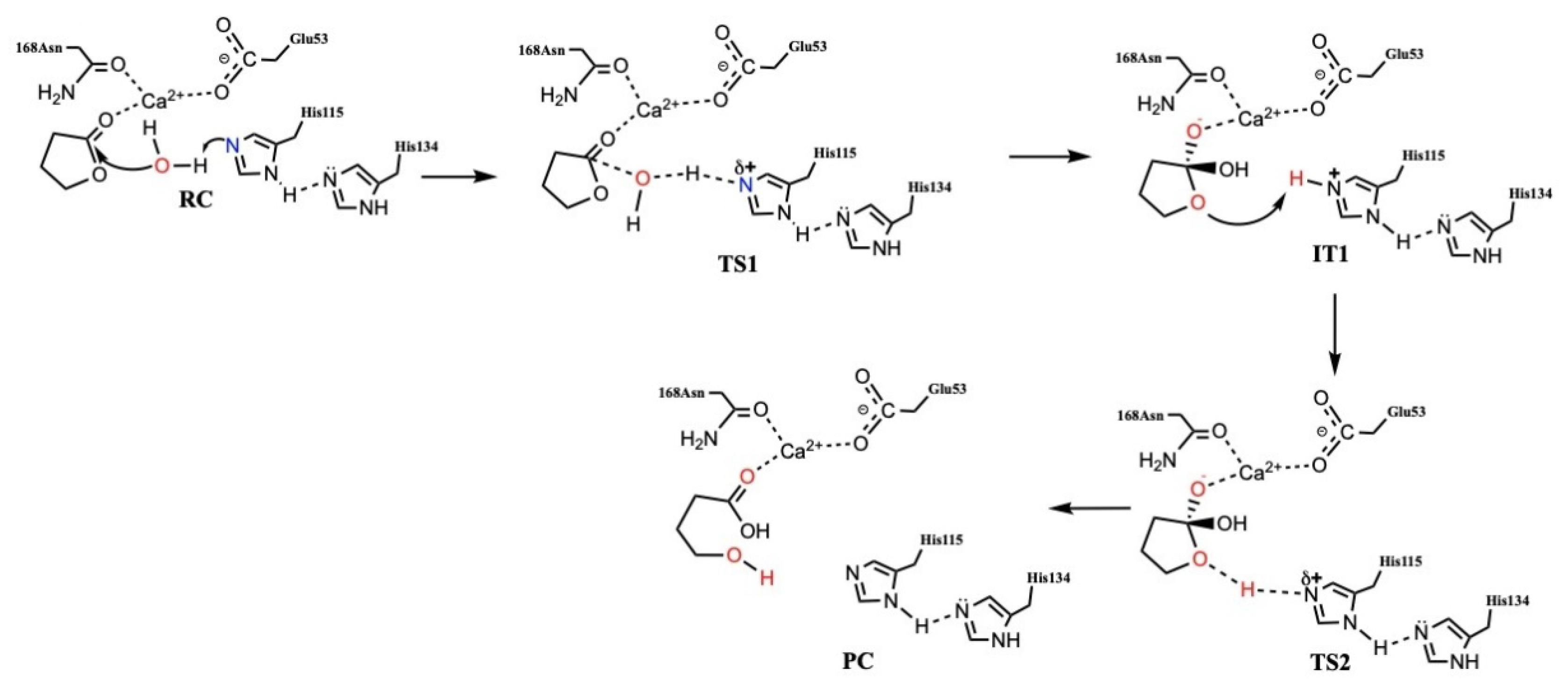
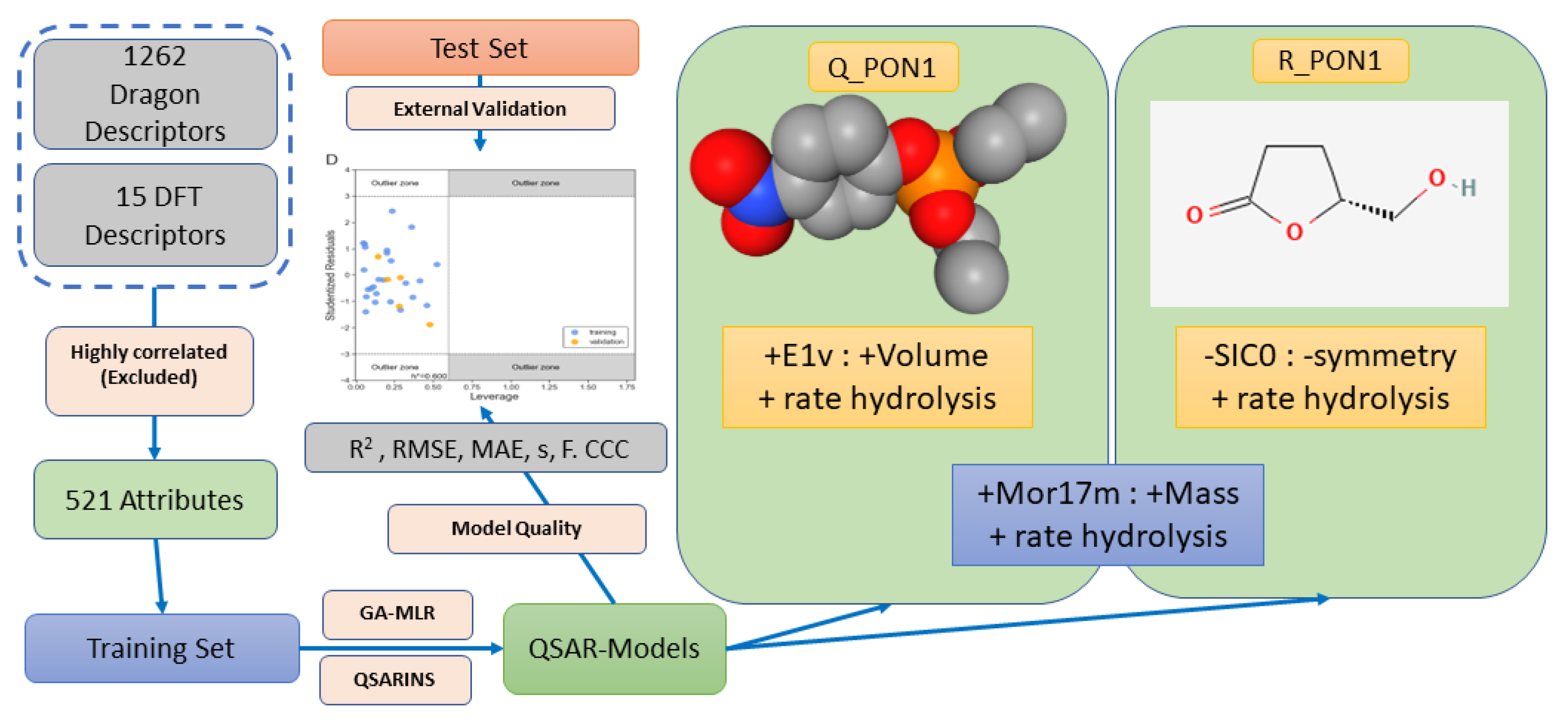
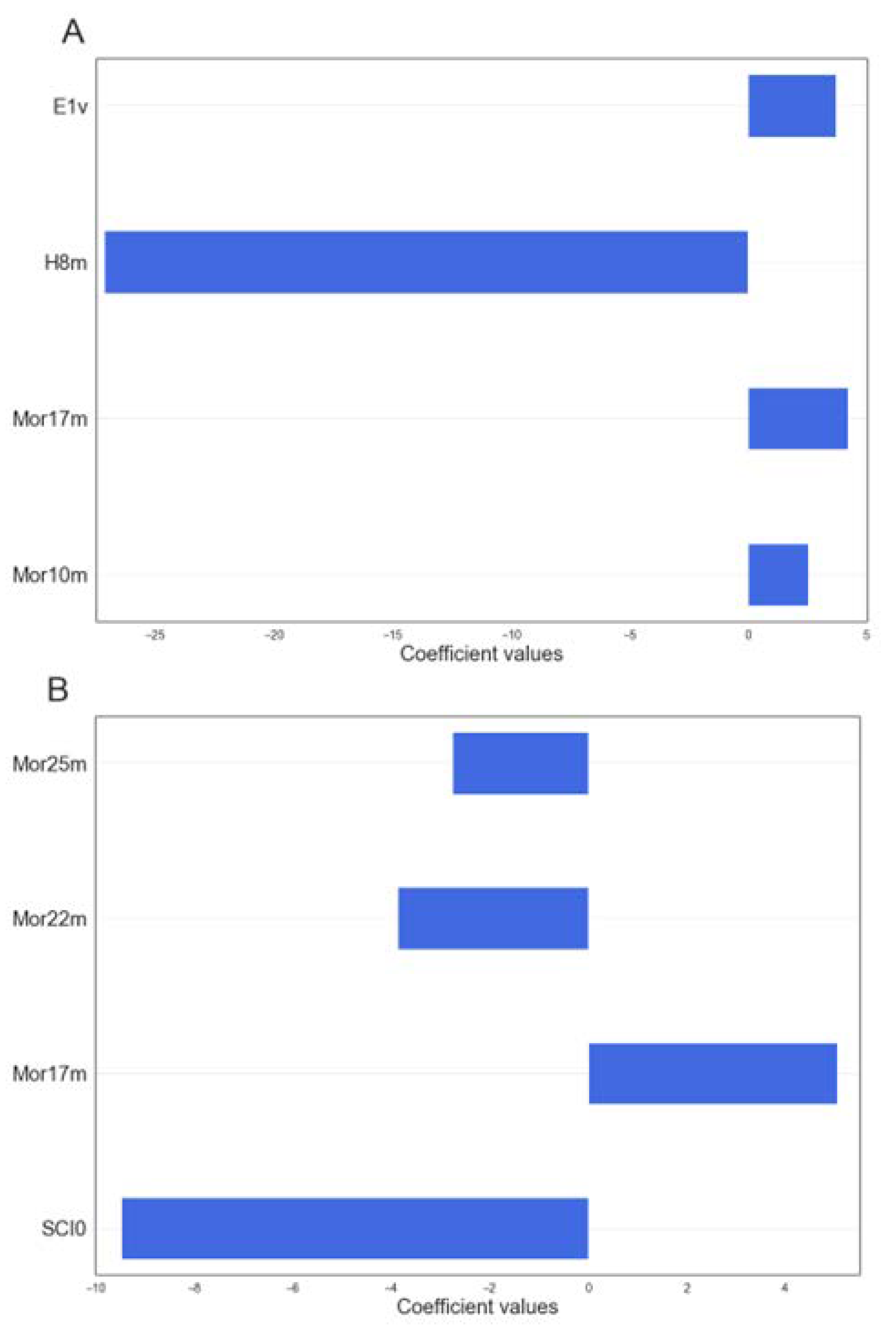
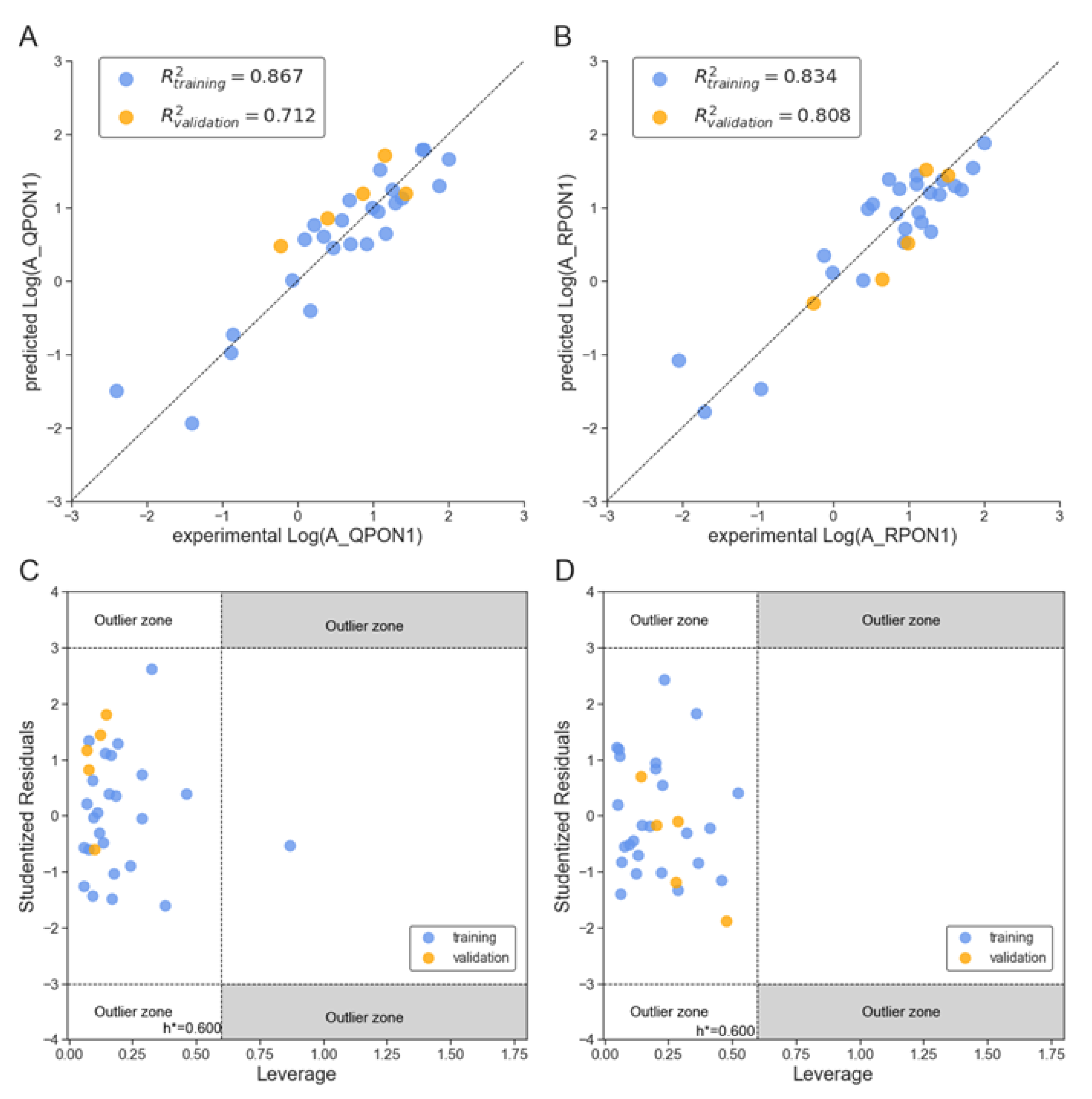
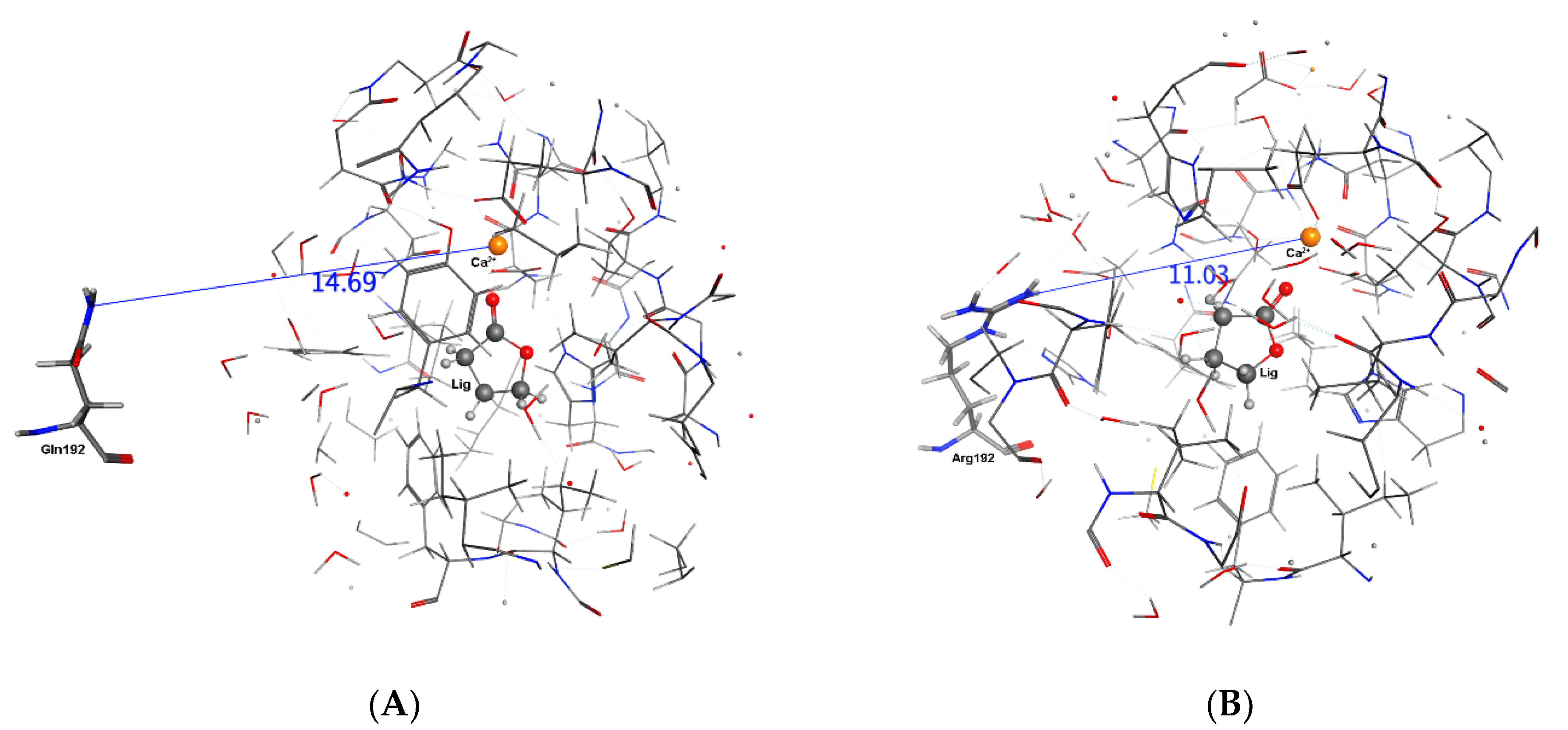


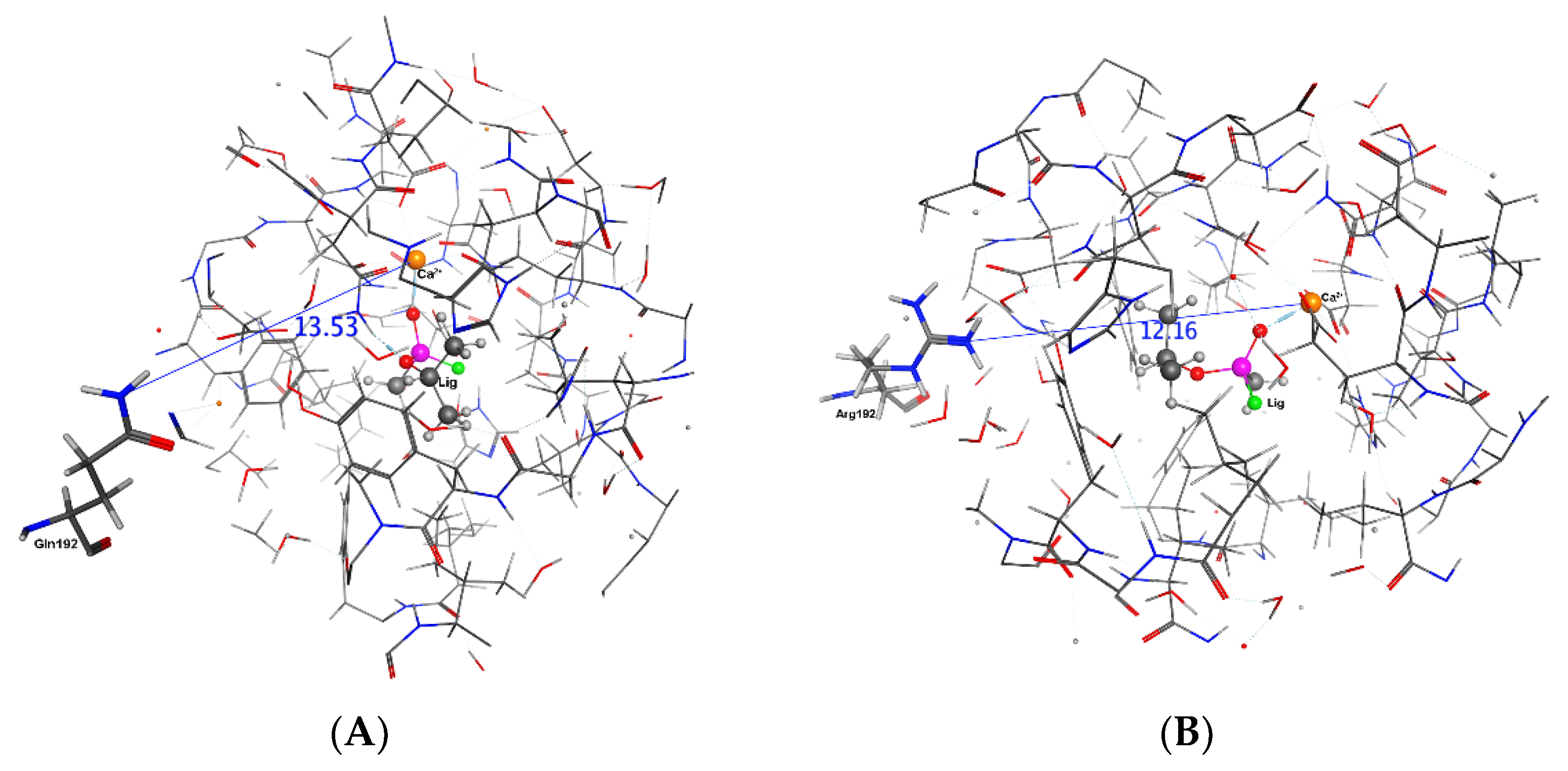
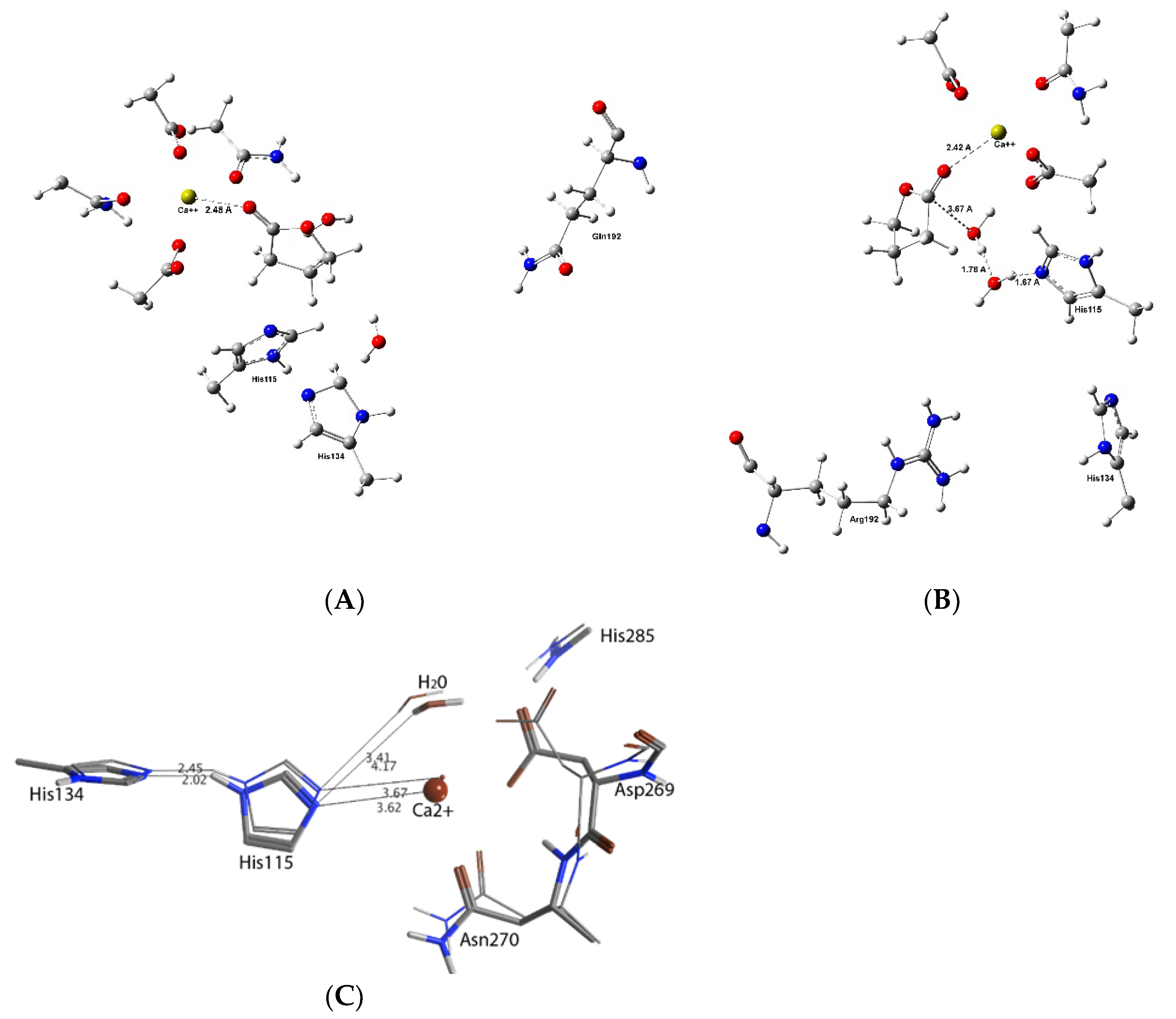
| No | Structure | Name | Human Q192 PON1 Rate of Hydrolysis | Human R192 PON1 Rate of Hydrolysis | Reference |
|---|---|---|---|---|---|
| 1 |  | Phenyl acetate | 100 | 100 | [21] |
| 2 |  | Paraoxon | 0.13 | 0.99 | [21,28] |
| 3 |  | 2-Coumaranone | 18.3 | 13.5 | [21] |
| 4 |  | Dihydrocoumarin | 14.3 * | 17.0 * | [21] |
| 5 |  | Homogentisic acid lactone | 44.0 | 49.7 | [21] |
| 6 |  | γ-Butyrolactone | 2.46 * | 9.05 | [21] |
| 7 |  | α-Bromo- γ -butyrolactone | 47.2 | 40.8 | [21] |
| 8 |  | S-α-Hydroxy-γ-butyrolactone | 8.14 | 19.6 | [21] |
| 9 |  | S-β-Hydroxy-γ-butyrolactone | 0.60 * | 0.76 | [21] |
| 10 |  | γ-Valerolactone | 7.28 * | 6.97 | [21] |
| 11 |  | R-Dihydro-5- hydroxymethyl)-2(3H)-furanone | 1.23 | 3.29 | [21] |
| 12 |  | γ-Decanolactone | 12.4 | 19.0 | [21] |
| 13 |  | Undecano-γ-lactone | 11.8 | 12.7 | [21] |
| 14 |  | α-Angelicolactone | 19.9 | 14.8 | [21] |
| 15 |  | β-Butyrolactone | 3.83 | 7.53 | [21] |
| 16 |  | δ-Valerolactone | 75.4 | 71.0 | [21] |
| 17 |  | δ-Decanolactone | 23.8 | 28.2 | [21] |
| 18 |  | Undecanoic-δ-lactone | 27.5 * | 32.8 * | [21] |
| 19 |  | δ-Dodecanolactone | 9.65 | 12.8 | [21] |
| 20 |  | ε-Caprolactone | 14.8 | 25.7 | [21] |
| 21 |  | Oxabicyclooctenone | 1.67 | 2.92 | [21] |
| 22 |  | γ-Thiobutyrolactone | 0.04 | 0.11 | [21] |
| 23 |  | HTL; homocysteine thiolactone | 0.004 | 0.009 | [21] |
| 24 |  | Propylene carbonate | 5.02 * | 8.80 | [21] |
| 25 |  | 4-(1-Propenyloxymethyl)-1,3- dioxolan-2-one | 2.23 | 2.52 | [21] |
| 26 | 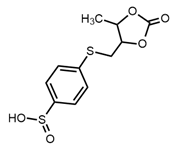 | 4-[(5-methyl2-oxo-1,3-dioxol-4-yl)methylthio] benzenesulfonate | 1.46 | 9.65 * | [21] |
| 27 |  | Sarin | 0.14 | 0.02 | [28] |
| 28 |  | Soman | 0.85 | 0.55 * | [28] |
| 29 |  | Diazoxon | 4.88 | 4.45 * | [28] |
| 30 | 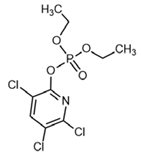 | Chlorpyrifos oxon | 2.97 | 5.40 | [28] |
| QPON1 | RPON1 | ||
|---|---|---|---|
| Abbreviation | Descriptor | Abbreviation | Descriptor |
| Mor10m | signal 10/weighted by mass 3D-MoRSE descriptors | SIC0 | Spectral moment 05 from edge adj. matrix weighted by dipole moments |
| Mor17m | signal 17/weighted by mass 3D-MoRSE descriptors | Mor17m | signal 17/weighted by mass 3D-MoRSE descriptors |
| E1v | First component accessibility directional WHIM index/weighted by van der Waals volume | Mor22m | signal 22/weighted by mass 3D-MoRSE descriptors |
| H8m | H autocorrelation of lag 8/weighted by mass | Mor25m | signal 25/weighted by mass 3D-MoRSE descriptors |
| Compound | QPON1 Isoenzyme | RPON1 Isoenzyme |
|---|---|---|
| γ-Butyrolactone | Complex1Q | Complex1R |
| Phenylacetate | Complex2Q | Complex2R |
| Paraoxon | Complex3Q | Complex3R |
| Sarine gas | Complex4Q | Complex4R |
| Fitting criteria |
| R2 tr = 0.867, R2adj = 0.841, RMSE = 0.378 MAE tr = 0.305, |
| CCC tr = 0.929, s = 0.422, F = 32.613 |
| Internal validation criteria |
| Q2LOO = 0.766, RMSE cv = 0.501, MAE cv = 0.401, |
| Q2LMO = 0.712, CCC cv = 0.881 |
| External validation criteria |
| R2ext. = 0.712, RMSE ext. = 0.491, MAE ext. = 0.463, CCC ext. = 0.628 |
| Fitting criteria |
| R2 tr = 0.834, R2adj = 0.080, RMSE = 0.407 MAE tr = 0.346, |
| CCC tr = 0.909, s = 0.455, F = 25.081 |
| Internal validation criteria |
| Q2lLOO = 0.726, RMSE cv = 0.522, MAE cv = 0.439, |
| Q2LMO = 0.683, CCC cv = 0.854 |
| External validation criteria |
| R2ext. = 0.808, RMSE ext. = 0.372, MAE ext. = 0.297, CCC ext. = 0.854 |
| Compound | Arg192---Ca2+ Distance | Gln192---Ca2+ Distance | His115---Ca2+ Distance RPON1 | His115---Ca2+ Distance QPON1 |
|---|---|---|---|---|
| γ-Butyrolactone (Figure 5) | 1.107 | 1.362 | 0.525 | 0.944 |
| Phenylacetate (Figure 6) | 1.417 | 1.404 | 0.468 | 0.865 |
| Paraoxon (Figure 7) | 1.226 | 1.669 | 0.233 | 0.879 |
| Sarine gas (Figure 8) | 1.457 | 1.253 | 0.921 | 0.846 |
| Substrate-free | 0.970 | 1.431 | 0.541 | 0.688 |
Publisher’s Note: MDPI stays neutral with regard to jurisdictional claims in published maps and institutional affiliations. |
© 2022 by the authors. Licensee MDPI, Basel, Switzerland. This article is an open access article distributed under the terms and conditions of the Creative Commons Attribution (CC BY) license (https://creativecommons.org/licenses/by/4.0/).
Share and Cite
Karabulut, S.; Mansour, B.; Casanola-Martin, G.M.; Rasulev, B.; Gauld, J.W. The Hydrolysis Rate of Paraoxonase-1 Q and R Isoenzymes: An In Silico Study Based on In Vitro Data. Molecules 2022, 27, 6780. https://doi.org/10.3390/molecules27206780
Karabulut S, Mansour B, Casanola-Martin GM, Rasulev B, Gauld JW. The Hydrolysis Rate of Paraoxonase-1 Q and R Isoenzymes: An In Silico Study Based on In Vitro Data. Molecules. 2022; 27(20):6780. https://doi.org/10.3390/molecules27206780
Chicago/Turabian StyleKarabulut, Sedat, Basel Mansour, Gerardo M. Casanola-Martin, Bakhtiyor Rasulev, and James W. Gauld. 2022. "The Hydrolysis Rate of Paraoxonase-1 Q and R Isoenzymes: An In Silico Study Based on In Vitro Data" Molecules 27, no. 20: 6780. https://doi.org/10.3390/molecules27206780
APA StyleKarabulut, S., Mansour, B., Casanola-Martin, G. M., Rasulev, B., & Gauld, J. W. (2022). The Hydrolysis Rate of Paraoxonase-1 Q and R Isoenzymes: An In Silico Study Based on In Vitro Data. Molecules, 27(20), 6780. https://doi.org/10.3390/molecules27206780








